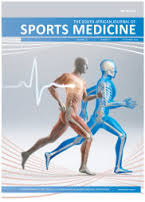Anterior Cruciate ligament injuries of the knee:
Patterns of association between the mechanism of injury and pathology seen on magnetic resonance imaging (MRI)
DOI:
https://doi.org/10.17159/2078-516X/2018/v30i1a5265Abstract
Abstract
Background and problem statement
Anterior cruciate ligament injuries are common among athletes and the general public. These injuries may lead to significant absence from activity with an associated financial and social burden. No definitive association has been described between mechanism of injury and pathology to enable us to put preventative measures in place in order to limit these injuries.
Aim
To determine whether there is an association between the mechanism of injury and the pathology seen on a magnetic resonance imaging (MRI) scan in anterior cruciate ligament (ACL) injuries.
Methods
This was a cross-sectional analytical study. Eighty seven male patients with an ACL injury, who had an MRI scan of the knee within the last two years participated in this study. Participants were contacted to give consent that their information be used in this study. The mechanism of injury and the pathology seen on the MRI scan was noted and categorised into different mechanism of injury groups and associated pathology groups. Statistical analyses included summaries of the data and a test for association between mechanism of injury and pathology. Since there were multiple pathology responses to each mechanism, a modified version of the chi-square test for independence was used. A 5% level of significance was specified.
Results
MRI scans of ACL injuries indicated that the mechanism of a solid foot plant with rotation of the knee has a greater tendency to be associated with medial meniscal injuries (77%), and also a 54% possibility to be associated with lateral meniscal injuries. A solid foot plant with a valgus stress on the knee showed a higher incidence of associated medial collateral ligaments (MCL) injuries (41%) and femoral bone bruising (62 %). These two mechanisms of injury are the most common in ACL injuries and contribute to the clinical significance found in this study. The p-value was however not statistically significant (p=0.44, chi-square value=20.27, df=45) for any association between pathology and mechanism of injury.
Conclusion
Some injury mechanisms causing ACL injury were more common than others and also had more associated pathology. The most common mechanism of injury noted is a solid foot plant with either rotation of the knee or valgus stress on the knee. Strengthening tissue structures involved in those movement patterns that cause these mechanisms can possibly limit ACL injuries in athletes and the general public.
Key words
Anterior cruciate ligament injury, mechanism, association, pathology, MRI scan, prevention.
Downloads
Downloads
Published
Issue
Section
License
Copyright (c) 2018 South African Journal of Sports Medicine

This work is licensed under a Creative Commons Attribution 4.0 International License.
The South African Journal of Sports Medicine reserves copyright of the material published. The work is licensed under a Creative Commons Attribution 4.0 (CC BY 4.0) International License. Material submitted for publication in the South African Journal of Sports Medicine is accepted provided it has not been published elsewhere. The South African Journal of Sports Medicine does not hold itself responsible for statements made by the authors.
How to Cite
- Abstract 1137
- PDF 808





.png)